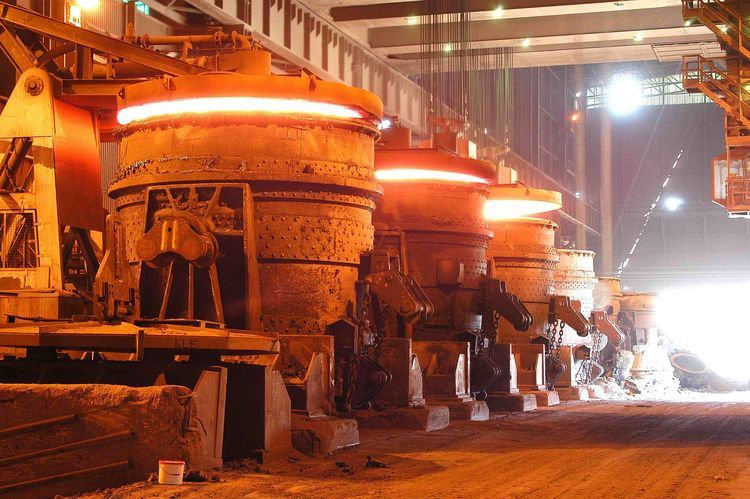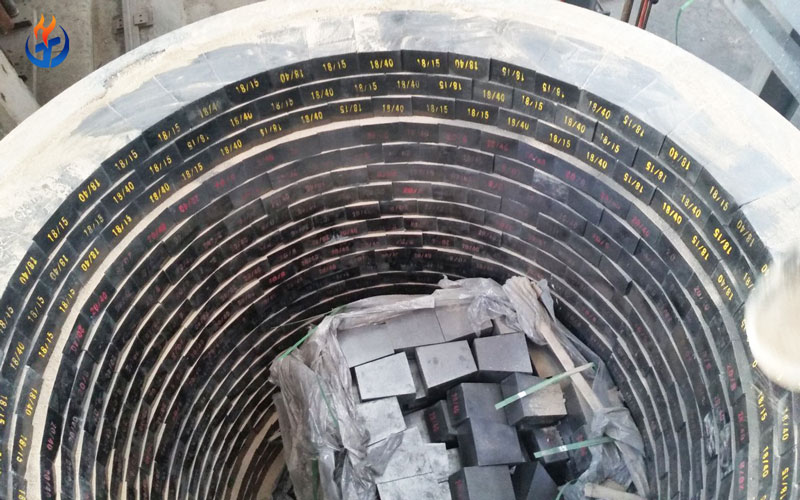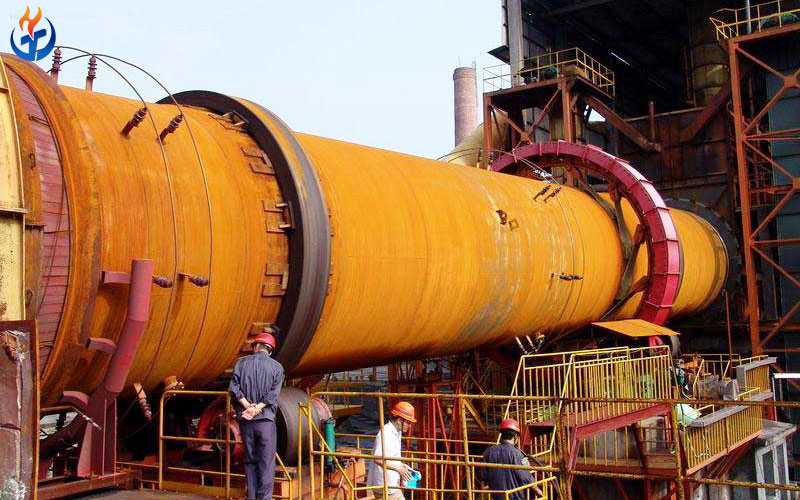In the modern steelmaking industry, Electric Arc Furnaces (EAFs) play a pivotal role, particularly in the production of high-quality steel using scrap metal as the main feedstock. These furnaces operate at extremely high temperatures—often exceeding 1700°C (3090°F)—and are subjected to intense thermal cycling, mechanical stress, and chemical corrosion.
Given this harsh operational environment, the internal lining of an EAF must be composed of refractory materials that can withstand prolonged exposure to extreme heat, resist slag penetration, and endure thermal shocks without cracking or spalling. Refractory bricks for EAF are the foundation of safe and efficient furnace operation. The choice of the right brick type directly impacts furnace longevity, maintenance schedules, and operational costs.
This article explores how to choose suitable refractory bricks for electric arc furnaces lining, focusing on different furnace zones, material properties, and the key role of MgO-C bricks in modern EAF designs.
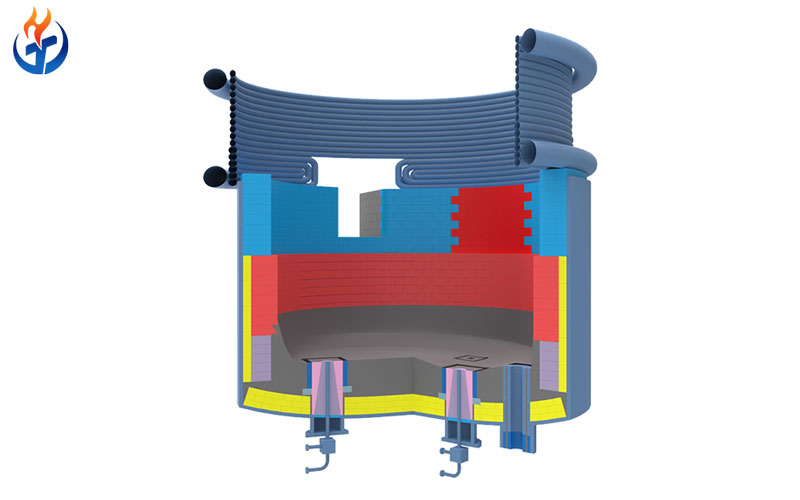
Role of Refractory Bricks in EAF Operations
The refractory lining inside an EAF is not merely a protective layer—it is a critical component of furnace functionality. Its primary purposes include:
Thermal containment: Preventing heat loss and ensuring efficient melting of scrap or DRI.
Chemical resistance: Withstanding the corrosive effects of basic slags, fluxes, and molten steel.
Structural support: Protecting the furnace shell from mechanical damage, abrasion, and arc exposure.
Thermal shock absorption: Surviving rapid heating and cooling cycles without failure.
Each area of the furnace experiences different conditions, and thus requires specialized refractory solutions. For instance:
The hearth and sidewalls must resist molten metal corrosion and physical impact.
The slag line, the area most exposed to chemical erosion, requires enhanced resistance to basic slags.
The roof, often exposed to arc radiation and gases, must withstand intense heat and sometimes requires cooling systems to reduce refractory wear.
Electric arc furnace lining is typically composed of multiple refractory layers, including working linings (exposed to molten metal and slag) and permanent back linings for insulation and structural support.
Key Areas of EAF Lining and Their Requirements
3.1. Hearth and Sidewalls
The hearth forms the base of the EAF and comes in direct contact with molten steel throughout the melting cycle. This area is continuously exposed to high temperatures, metallic erosion, and the intense energy of electric arcs.
Material Requirements: Refractory bricks in the hearth and lower sidewall must offer high thermal conductivity, abrasion resistance, and chemical inertness to both molten steel and slag.
Common Solution: High-density magnesia bricks or MgO-C bricks, which combine the high melting point of MgO with the thermal shock resistance of graphite.
The sidewalls, especially the upper regions, are frequently attacked by arcs, splashes of molten steel, and fume turbulence. Their linings must be mechanically robust and able to cope with rapid temperature fluctuations.
3.2. Slag Line
The slag line is the most vulnerable area of the EAF lining. Located at the interface between the molten metal and slag, this zone endures severe chemical corrosion, fluctuating temperatures, and mechanical agitation due to the continuous tapping and charging process.
Solution of Choice: MgO-C bricks have become the industry standard in this zone due to their:
Superior slag resistance
Excellent thermal shock resistance
Ability to resist spalling
Moderate oxidation protection, especially when enhanced with anti-oxidants such as aluminum or silicon.
The presence of carbon (graphite) in MgO-C bricks helps reduce slag wetting and inhibits penetration, while the magnesia ensures basicity compatibility with the furnace slag.
3.3. Furnace Roof and Hot Zones
The roof of the EAF is subjected to the most extreme thermal environment, especially under direct arc radiation and hot fume circulation. Depending on furnace design, the roof may be made from:
Alumina-based refractories
Basic castables
Or even water-cooled panels in high-capacity furnaces
Although not all roof areas use bricks, where bricks are applied, they must offer lightweight thermal resistance, high refractoriness, and good durability under rapid cycling.
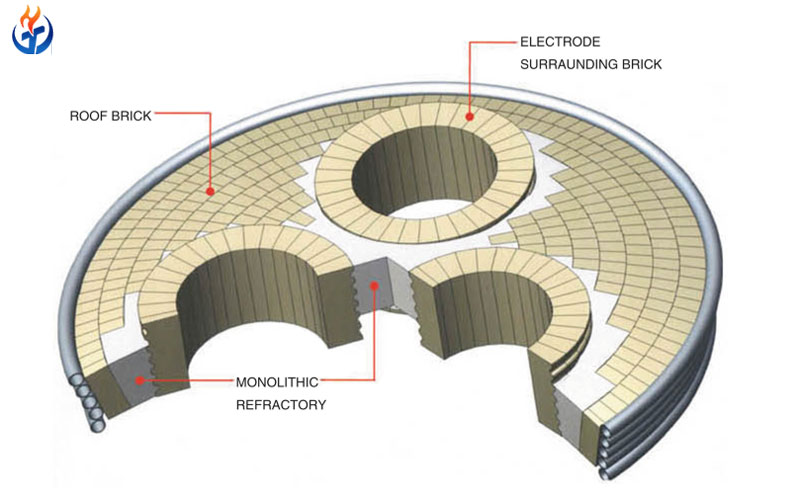
Types of Refractory Bricks for EAF
Different types of refractory bricks for EAF are engineered to meet specific performance demands in high-temperature zones. Here’s an overview of the most widely used refractory brick types in EAFs:
4.1 Magnesia Bricks
Magnesia bricks are made from high-purity magnesium oxide (MgO) and are highly resistant to basic slags, making them suitable for steelmaking environments. These bricks are typically used in less aggressive furnace areas or as part of permanent linings.
Properties:
Refractoriness above 2000°C
High thermal conductivity
Excellent compatibility with basic slags
Limitations: Lower thermal shock resistance than MgO-C bricks
4.2 Magnesia-Carbon (MgO-C) Bricks
MgO-C bricks are the dominant choice for the working lining in EAFs, especially in the slag line and hot spots. These bricks combine the corrosion resistance of magnesia with the thermal shock resistance and low wettability of graphite.
Composition: Typically 70–90% MgO and 10–20% graphite
Advantages:
Outstanding resistance to spalling and slag attack
Good oxidation resistance when treated with antioxidants (e.g., Al, Si, B)
Excellent performance under fluctuating thermal conditions
Common Uses: Slag line, sidewalls, tap hole areas
MgO-C bricks are particularly effective in EAFs that operate at high power input levels, where arc flare and hot spots accelerate refractory wear.
4.3 Alumina-Based Bricks
High-alumina bricks, generally made from aluminum oxide (Al₂O₃), are used in less aggressive zones such as the roof or in back-up linings. While alumina offers good refractoriness, it is more suitable for acidic or neutral slag environments, and less so for areas exposed to basic slags.
Pros:
High compressive strength
Lower cost than MgO-C bricks
Cons:
Poor compatibility with basic slags
Lower thermal shock resistance
4.4 Precast Refractory Blocks
Some EAF designs now use precast refractory blocks, especially in areas like tap holes, spouts, or burner blocks. These monolithic units provide structural integrity and are easier to replace during maintenance shutdowns.
Selection Criteria: How to Evaluate Brick Performance
Choosing the right refractory bricks for EAF requires a detailed understanding of your furnace’s operational parameters. Below are the main selection criteria that should guide your decision:
5.1 Refractoriness
Indicates the material’s ability to withstand high temperatures without softening or melting.
Ideal Range: > 1700°C for EAF linings
MgO-C bricks and magnesia bricks typically offer the highest refractoriness.
5.2 Thermal Shock Resistance
Critical for areas experiencing rapid heating and cooling, such as slag lines and sidewalls.
High graphite content improves shock resistance.
MgO-C bricks are the best performers in this regard.
5.3 Slag Resistance
The brick’s resistance to chemical attack by basic steelmaking slags.
Magnesia content provides basicity compatibility.
MgO-C bricks have high slag resistance due to carbon’s low wettability.
5.4 Oxidation Resistance
Carbon is prone to oxidation at high temperatures in the presence of oxygen.
Anti-oxidants (e.g., aluminum, silicon, boron compounds) are added to MgO-C bricks to delay oxidation.
Crucial in furnaces with high oxygen injection or long tap-to-tap times.
5.5 Mechanical Strength
High cold crushing strength (CCS) is essential for sidewalls and hearth zones under mechanical impact.
Dense magnesia bricks and MgO-C bricks show high CCS values (>30 MPa typically).
5.6 Apparent Porosity and Density
Lower porosity improves resistance to slag and metal penetration.
Higher density enhances durability but increases thermal conductivity (and heat loss).
Balanced selection depends on whether you prioritize energy saving or brick longevity.
5.7 Economic Considerations
Consider service life vs. cost per ton of steel produced.
MgO-C bricks may have a higher upfront cost but result in lower maintenance and downtime.
🔍 Tip: Always consult your EAF’s operational history and wear patterns when choosing brick types. A customized brick mix based on actual stress zones can improve performance and reduce cost.
Installation & Maintenance Best Practices
Even the best refractory bricks will underperform if not installed and maintained properly. Here’s how to ensure long-term success:
6.1 Proper Installation
Preheat refractory bricks to remove residual moisture and reduce thermal shock.
Use refractory mortar or specialized jointing materials for tight seams.
Maintain recommended expansion joints to accommodate thermal expansion and prevent spalling.
6.2 Furnace Conditioning
Conduct dry-out procedures before full operation to avoid steam damage.
Gradually ramp up temperature to allow bricks to adapt to furnace conditions.
6.3 Gunning and Patching
Hot gunning is a common repair method in EAFs, allowing quick patching during short shutdowns.
Use MgO-based gunning materials compatible with the existing lining.
6.4 Wear Monitoring
Install thermocouples or use infrared scanning to detect hot spots or premature wear.
Maintain a brick wear log for every campaign to track erosion patterns and improve future material selection.
6.5 Oxidation Control
In oxygen-rich environments, carbon burnout is a serious concern.
Protect MgO-C bricks using coating sprays, gas shielding, or anti-oxidant additives.
Common Failures and Prevention Strategies
Even with optimal material selection and installation, refractory bricks for EAF can experience wear and failure over time. Understanding common failure modes helps in refining maintenance strategies and increasing lining life.
7.1 Thermal Spalling
Cause: Rapid temperature changes during charging or tapping cycles
Effect: Cracks, flaking, and eventual brick loss
Prevention:
Use MgO-C bricks with high thermal shock resistance
Implement gradual preheating and cooling cycles
Avoid water leaks and sudden cold charging
7.2 Slag Erosion
Cause: Aggressive contact with basic slags rich in FeO, CaO, and SiO₂
Effect: Penetration and weakening of the brick matrix
Prevention:
Select bricks with high slag resistance, like MgO-C
Use anti-wetting coatings or slag conditioners
Optimize furnace chemistry to reduce slag aggressiveness
7.3 Carbon Oxidation
Cause: Oxygen exposure at high temperatures leads to graphite burnout in MgO-C bricks
Effect: Reduced mechanical strength, accelerated wear
Prevention:
Use anti-oxidant additives in brick formulations
Limit excess oxygen injection
Apply protective coatings in oxygen-rich areas
7.4 Mechanical Damage
Cause: Scrap impact, arc flare, and charge collapse
Effect: Breakage, chipping, and premature wear
Prevention:
Reinforce vulnerable areas with dense, high-strength bricks
Monitor arc control systems to reduce flare
Use slag splash coating to protect lower wall regions
By identifying the root causes of lining failure, steel plants can extend refractory campaign life, reduce unplanned outages, and improve furnace availability.
Xintai Refractory Solutions for EAF
With over 20 years of experience in refractory manufacturing and export, Xintai Refractory is a trusted supplier of advanced materials for electric arc furnaces worldwide.
What We Offer:
MgO-C Bricks for slag lines and sidewalls
Magnesia Bricks for hearth and back linings
Precast Shapes for tap holes, burner blocks, and spouts
Monolithic Refractories for gunning, patching, and permanent linings
Custom Formulations tailored to your EAF design and steel grade
Why Choose Xintai?
✅ High-purity raw materials ensure superior performance
✅ In-house R&D and quality testing for consistency
✅ Fast global delivery and export compliance
✅ Expert technical support and installation guidance
✅ Long-term partnerships with steel mills and engineering companies
Our team works closely with steel producers to design cost-effective and high-performance electric arc furnace lining solutions, ensuring safety, longevity, and operational efficiency.
📞 Contact us today to discuss your refractory needs and request a quote.
Conclusion
Choosing the right refractory bricks for EAF is essential for maintaining a safe, efficient, and cost-effective steelmaking operation. The electric arc furnace lining is subjected to some of the harshest conditions in the industry—thermal shock, chemical corrosion, and mechanical impact.
Among available materials, MgO-C bricks have proven to be the most reliable for key wear zones like the slag line and sidewalls, thanks to their combined thermal resistance and chemical durability.
However, success doesn’t end with material selection. Proper installation, regular maintenance, and wear monitoring are all vital to maximizing refractory performance and minimizing downtime.

